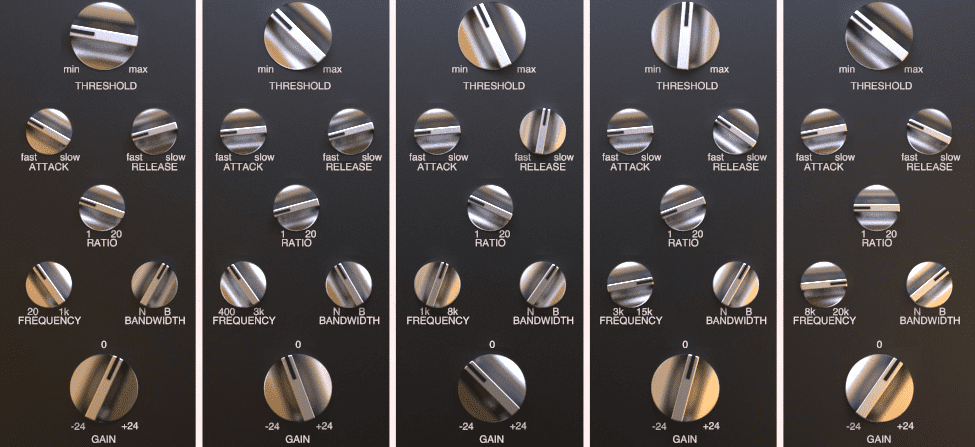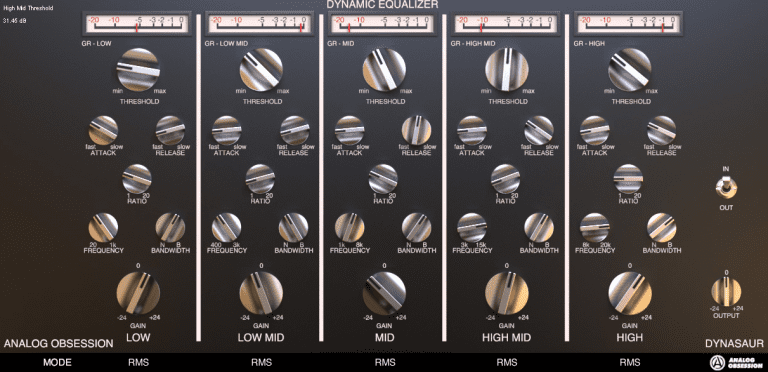The Art of Multiband Compression
In the complex field of audio mixing, compression is emerging as an indispensable tool to control signal dynamics sound.
It intervenes by reducing volume variations between loud and soft parts. It provides sound coherence essential for a professional and balanced mix.
Multi-band compression therefore represents a significant advance in this well-established practice.
Unlike standard compression, which treats the entire audio spectrum in a uniform manner, multiband compression divides the signal into several frequency bands. It offers precise control over each portion of the sound spectrum.
This sophisticated approach allows dynamic problems to be addressed in a targeted manner, while preserving the integrity of the rest of the mix.
Understanding Multiband Compression
Multi-band compression works by subdividing the audio spectrum into different frequency bands, each being processed independently by a dedicated compressor.
This segmentation therefore makes it possible to specifically target dynamic problems in each band. This therefore provides flexibility and unprecedented control over mixing.
Unlike standard compression, which acts uniformly across the entire audio signal, multiband compression allows for more nuanced and granular treatment.
By adjusting the compression parameters for each frequency band separately, sound engineers can correct the dynamic imbalances while preserving the overall character of the mix.
Applications of multiband compression
Multi-band compression provides exceptional versatility in dealing with dynamic issues specific to each frequency band.
For example, in an audio mix, it is common to encounter problems such as excess low frequency or excessive brightness in the treble.
With multi-band compression, these problems can therefore be corrected in a targeted manner. This is possible by applying different compression to each frequency band.
In addition, multi-band compression is particularly effective for creating tonal balance harmoniousin the mix.
By adjusting the compression on each frequency band separately, audio engineers can sculpt the sound in a way that precise. You must highlight the essential elements of the music and attenuate unwanted frequencies.
This provides a balanced and coherent final mix. This provides an enjoyable listening experience and immersive.
In addition, multiband compression can be used creatively to shape sonic character of an audio track.
For example, by emphasizing or attenuating certain frequencies, sound engineers can give music a unique and distinctive color that matches the desired artistic aesthetic.
This allows you to explore new sonic possibilities and add an extra dimension to music production.
Finally, multiband compression is an indispensable tool in the field of audio mastering.
This provides professional, high-quality sound that stands out in a competitive musical environment.
Selecting Compression Settings
A key aspect of using multiband compression effectively is judicious selection of compression settings for each frequency band.
These parameters include threshold, ratio, attack time and release timet, which therefore determine how compression is applied to each frequency band.
Adjusting compression settings depends largely on the specific characteristics of the audio track and processing goals.
For example, to correct excess low frequency, it may be necessary to apply more aggressive compression with a lower threshold in the corresponding frequency band.
On the other hand, to equalize the sound level across the entire spectrum, more subtle and balanced adjustments may therefore be appropriate.
It is important to note that the use of the Spectrum Analyzer can be extremely useful in guiding the settings of compression.
This tool allows you to graphically visualize the distribution of frequencies in the sound spectrum, making it easier to identify problem areas and fine-tuning compression settings accordingly.
In addition, we therefore recommend taking a step-by-step approach when adjusting compression settings.
Rather than abruptly changing settings, it is often more effective to proceed in small steps. Listen carefully to the effects of each adjustment and adjust the parameters iteratively to achieve the desired sonic result.


Creative use of multiband compression
Multi-band compression offers audio engineers the opportunity to explore advanced audio processing techniques to shape the sound creatively.
Among these techniques is the ability to sculpt sound by emphasizing or attenuating specific frequencies in the audio spectrum.
For example, by using multiband compression selectively, audio engineers can boost low frequencies to give an audio track more punch and depth. On the contrary, they can also attenuate high frequencies to soften cymbals that are too bright.
In addition, multiband compression allows precise control of dynamics, which can be particularly useful for achieving a mix transparent and balanced audio.
For example, by applying light compression to midrange frequencies, audio engineers smooth out volume variations and create a more homogeneous sound. The objective is also to preserve the natural dynamics of other parts of the sound spectrum.
This results in a final sound more coherent and pleasant to listen to, without compromising overall sound quality.
Advanced multiband compression techniques
Besides its basic applications, multiband compression also offers advanced possibilities for experienced audio engineers.
Among these advanced techniques is multi-band parallel compression, which consists of mixing the compressed signal with the uncompressed signal compressed to achieve more precise control of dynamics and sound color.
Parallel compression multi-band allows audio engineers to apply different compression to each frequency band. It allows these compressed signals to be mixed with the original signal to obtain the final sound.
This technique provides maximum flexibility for shaping sound creatively, allowing for subtle adjustments to dynamics and sound texture at every stage of the audio mixing process.
This allows for unique and personalized sonic results, that stand out in an ever-changing musical landscape evolution.
Case studies and practical examples
To illustrate the effectiveness and versatility of multiband compression, let’s look at some case studies and practical examples.
In music production, multiband compression is widely used to equalize the dynamics of individual tracks and final mixing.
For example, in electronic music, producers often use multiband compression to control low frequencies and percussion elements. The mix becomes balanced and punchy.
Similarly, in audio mastering, multiband compression is an indispensable tool for optimizing dynamics and clarity of the final mix.
Audio engineers typically use multi-band compression to equalize the sound level across the entire frequency spectrum. They ensure that every element of the music is clearly audible and balanced in the final mix.
This approach ensures consistent, professional final audio that stands out across all streaming platforms.


Tips to Avoid Common Mistakes
Although multiband compression is a powerful tool for audio processing, it is important to use it with caution to avoid common mistakes.
One of the most common mistakes is overcompression, where sound engineers apply excessive compression to each frequency band. This leads to a loss of dynamics and a muffled sound.
To avoid this, it is recommended to take small steps when adjusting compression and listen carefully to the effects of each adjustment.
Another common error is the appearance of unwanted artifacts, such as distortions or pumping, resulting from inappropriate compression.
To minimize these artifacts, it is essential to choose appropriate compression settings for each frequency band and adapt settings based on the specific characteristics of the audio track.
In addition, critical listening and incremental adjustments are recommended to achieve a optimal result!
Conclusion
In conclusion, multiband compression is an essential tool in the field of audio processing, giving audio engineers flexibility and precise control over dynamics and sound color.
Through this article, we have explored in depth the fundamental principles, the varied applications as well as the advanced techniques of multiband compression.
We also saw how this technique can be used creatively to shape sound selectively and subtly, as well as as for equalizing dynamics in audio mixing and mastering.
In addition, we have provided valuable tips to avoid common mistakes and maximize the effectiveness of the multiband compression.

